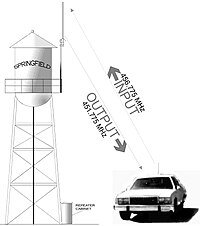Radio repeater
A repeater sited at a high elevation can allow two mobile stations, otherwise out of line-of-sight propagation range of each other, to communicate.
Some repeaters use two different frequency bands to provide isolation between input and output or as a convenience.
A repeater is an automatic radio-relay station, usually located on a mountain top, tall building, or radio tower.
In general, isolating the receiver from the transmitter is made easier by maximizing, as much as possible, the separation between input and output frequencies.
Although the repeater site must be capable of simultaneous reception and transmission (on two different frequencies), mobile stations can operate in one mode at a time, alternating between receiving and transmitting; so, mobile stations do not need the bulky, and costly filters required at a repeater site.
In some countries, under some radio services, there are agreed-on conventions or separations that are required by the system license.
In same-band repeaters, isolation between transmitter and receiver can be created by using a single antenna and a device called a duplexer.
Second, the transmit leg attenuates the transmitter broadband noise on the receiver frequency, also typically by 90-100 dB.
There is often not enough tower space to accommodate a separate antenna for each repeater at crowded equipment sites.
The multicoupler amplifies the signals reaching the antenna, then feeds them to several receivers, attempting to make up for losses in the power dividers (or splitters).
These operate similarly to a cable TV splitter but must be built to higher quality standards so they work in environments where strong interfering signals are present.
Transmitters usually have directional devices installed along with the filters that block any reflected power in the event the antenna malfunctions.
The antenna must have a power rating that will handle the sum of energy of all connected transmitters at the same time.
In trunked systems with many channels, a site design may include several transmit antennas to reduce combining network losses.
If one were to measure received signal levels, this would cause a variation among channels on a single trunked system.
Signals received by a base station on 153.755 MHz would go over the trunked system on an assigned talk group.
Voting comparators with a transmitter keying matrix are sometimes used to connect incompatible base stations.
These links, known as fixed stations in US licensing, typically connect an equipment site with a dispatching office.
In these systems, the hand-held works so long as it is within range of the low power mobile repeater.
Vehicular repeaters are complex but can be less expensive than designing a system that covers a large area and works with the weak signal levels of hand-held radios.



